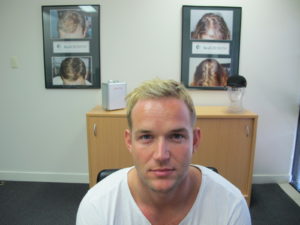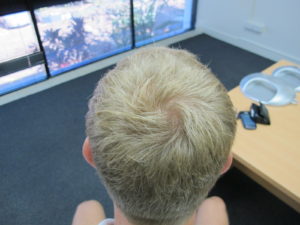A wave of young Australians are taking preventative action to retain their full crop of hair by commencing hair loss treatment in their twenties.1
This is according to the Hair Loss Impact and Prevention survey – the largest Australian hair loss survey of its kind, performed by Ashley and Martin, involving 1,122 Australian respondents aged between 15 to 70 years.
The survey revealed more than two-in-three respondents aged between 21 to 30 had taken early action against hair loss, citing they felt too young to have to contend with a hair problem.1
Survey lead, hair transplant surgeon, cosmetic physician and Medical Director, Ashley and Martin Australia, Dr Mario Terri, Perth said 61 per cent of respondents first began noticing hair loss between 21 to 30 years of age, 56 per cent of whom first sought treatment for such.1
“More than 80 per cent of men2 and about 55 per cent of women3 will experience hair loss at some stage in their lives. However, clinical research shows hair loss can commence even before the age of 21,4 with significant balding affecting about 20 per cent of men in their 20s, 30 per cent of men in their 30s and nearly half of all men by the time they’re in their 40s.5
“Our research survey reveals many Australians are now recognising hair loss can start much earlier than anticipated, and are therefore, working proactively to maintain their youthful locks,” Dr Terri said.
“Hair loss can significantly compromise self-confidence and wellbeing, and there are distinct links between hair loss, its associated stigma and psychosocial problems.”6
Notably, 72 per cent of Hair Loss Impact and Prevention survey respondents claimed they would continue to treat their hair loss for as long as they could, with almost 63 per cent of those on treatment stating they either felt relieved there was a proven medical treatment program (28.8 per cent), or trusted the advice given by their Ashley and Martin consultant or doctor (33.8 per cent).1 A further 78.4 per cent of those treated were satisfied with improvements resulting from the latest treatments on offer.1
“The Hair Loss Impact and Prevention survey provides insights into the personal impact of hair loss, and the perceived issues that people encounter with hair regrowth treatments, helping us to better understand how to treat them successfully,” said Dr Terri.
“Hair loss remains a touchy subject, with the survey revealing three-out-of-five respondents failed to discuss their hair loss, even with those closest to them.1
“Thanks to the latest treatment developments, including non-surgical hair regrowth options, we’re able to offer solutions to those who are anxious about losing their hair before it’s too late,” Dr Terri said.
Ian, 30, Gold Coast, regained a full head of hair within five months of commencing hair loss treatment, changing career paths to become an Ashley and Martin Practice Manager, in order to help others achieve similar success.


“When I first started noticing I was losing my hair at the age of 23, it took a toll on my confidence.
“I knew it was going to happen at some point in time, because all of my Uncles on my mum’s side of the family are bald. But it happened very quickly,” said Ian.
“I was the only one in my group of friends experiencing hair loss, and I avoided discussing it with them. I mentioned it only jokingly with my brothers, who too, were losing hair.
“It wasn’t until a night out with a friend, that I chose to start researching my hair loss options, and promptly organised a visit to my local Ashley and Martin clinic on the Gold Coast the following day,” Ian said.
“I’d heard of Ashley and Martin, and knew they were experienced in treating hair loss, so I decided to go in and meet with them. When they explained the various treatment options to me, I decided to give it a go – I had nothing to lose but more hair.
“My treatment took between one-to-two minutes a day. Within four months, people were commenting on my hair growth, and were even mistakenly asking whether I’d undergone surgery. Within five months, I had a full head of hair,” said Ian.
“It was a great confidence boost, and today, I feel completely at ease with my hair. I’m confident in business, in my everyday life, and I’m in control of my hair loss.”
Cosmetic physician, Dr Terri Labberton, Melbourne, has developed many personalised hair regrowth plans for Ashley and Martin nation-wide. She explains many Australians who experience hair loss are unaware of the scientifically proven, non-surgical treatment options available today.
“There are multiple treatment options available to those living with hair loss, and the majority of patients are surprised at how well these treatments work for them.
“Our focus is on ensuring our patients re-grow and retain, as much of their own hair as possible. This is achieved by unique treatments that stimulate hair follicles to regenerate a person’s own hair,” Dr Labberton said.
“While our success record sits at 98 per cent, the key to increasing an individual’s chance of success, is to act quickly.”
Hair loss, medically known as alopecia, affects both men and women.7 There are various causes, including genetics or family history, together with environmental factors, such as stress and illness.7,8
The onset of hair loss can lead to a negative impact on self-esteem and psychosocial problems, including depression.6
People experiencing early signs of hair loss, who are seeking early preventative action, can visit www.ashleyandmartin.com for more information.
References
- Ashley and Martin. The Hair Loss Impact and Prevention November 2016.
- American Hair Loss Association. Men’s Hair Loss. Available at http://www.americanhairloss.org/men_hair_loss/ [last accessed December, 2016].
- Dinh QQ and Sinclair R. Female pattern hair loss. Current treatment options. Clin Interv Ageing. 2007; 2(2): 189-199.
- International Society of Hair Restoration Surgery. Article: Young male hair loss. http://www.ishrs.org/articles/young-male-hair-loss.htm [last accessed December 2016].
- Andrology Australia. Male Pattern Hair Loss Fact Sheet. Available at https://www.andrologyaustralia.org/male-pattern-hair-loss/ [last accessed December, 2016].
- Alfonso M, Richter-Appelt H, Tosti A, Viera MS and Garcia M. The psychosocial impact of hair loss among men: a multinational European study. Current Medical Research and Opinion. 2005; 21(11): 1829-1836.
- Better Health Channel. Patterned Hair Loss. https://www.betterhealth.vic.gov.au/health/conditionsandtreatments/patterned-hair-loss [last accessed December, 2016].
- American Hair Loss Association. Causes of Hair Loss. Available at http://www.americanhairloss.org/men_hair_loss/causes_of_hair_loss.asp [last accessed January, 2017].
NOTE: The national Hair Loss Impact and Prevention survey was conducted by Ashley and Martin, and independently audited by Watkins Coffey Martin, Chartered Accountants, Sydney.
